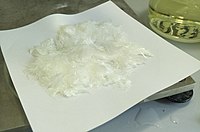
Photo from wikipedia
Abstract Mesostructured titania (Anatase) and silica (MCM-41) were proposed as supports to design highly active, selective, and regenerable FeIII-based nanostructured sorbents for mid-temperature H2S removal in a model sour syngas.… Click to show full abstract
Abstract Mesostructured titania (Anatase) and silica (MCM-41) were proposed as supports to design highly active, selective, and regenerable FeIII-based nanostructured sorbents for mid-temperature H2S removal in a model sour syngas. The resulting sorbents (Fe–SiO2 and Fe–TiO2) were tested as H2S removers at 300 °C and exhibited high reactivity and regenerability over repeated sulfidation cycles, with the best sorption performances achieved by the silica-based sorbent. Specifically, Fe–SiO2 showed a constant sorption capacity of 19 ± 1 mgS gsorbent−1 after the first sulfidation cycle. Meanwhile, a lower sorption capacity of 10 ± 1 mgS gsorbent−1 was found for the Fe–TiO2 composite. As evidenced by combining 57Fe Mossbauer spectroscopy with DC magnetometry, the nature (amorphous or crystalline) and composition (SiO2 or TiO2) of the inorganic mesostructures played a crucial role in the formation of the ultrasmall FeIII-active phase: maghemite (γ-Fe2O3) and pseudobrookite (Fe2TiO5) in the case of silica and titania, respectively. Therefore, the performance can be mainly justified in the light of the different reactivity of the active phases (Fe2O3 vs Fe2TiO5). FeIII-active phase in the form of ultrasmall Fe2O3 nanoparticles (about 2 nm) homogeneously dispersed in a highly stable mesostructured silica support assured high reactivity (85%–100% of the active phase involvement) and regenerability in the mid-temperature range as for the sulfidation run during the repeated sulfidation cycles (steady performances) avoiding the common drawbacks of unsupported sorbents (unreacted core and sintering phenomena causing loss of activity).
Journal Title: Microporous and Mesoporous Materials
Year Published: 2020
Link to full text (if available)
Share on Social Media: Sign Up to like & get
recommendations!